July,20 (8).
The Battle At Saltanovka.
July, 23 (11)
(From P.A.Zhilin "The Patriotic War Of 1812", Moscow,1988;
E.V.Tarle,Complete Works, Volume VII, "Napoleon's Invasion to Russia", Moscow 1959,
The collection of materials of the museum-panorama "The Borodino Battle" by I.A.Nickolaeva, N.A.Kolosov, P.M.Volodina, the 3-rd edition, Moscow,1985)
 Marshal Davout
Marshal Davoutby Bylon |
The troops of General Raevsky were near Stary Bykhov. On the way to Mogilev, 6 kilometers far from the city, the Russian vanguard, consisting of the cavalry of Count Sivers was stopped by the a French horse chasseur regiment. In the ensuing skirmish, the Russians surrounded the horse chasseurs, inflicting great losses: about 500 killed or wounded, more than 200 captured, the rest fled.
This alarmed Marshal Davout. He decided to defend Mogilev and sent 28 thousand men to the village of Saltanovka where he had an advantageous position and stationed them over one of the tributaries of the Dnieper river.
But Bargation decided to work towards Mogilev with fire and bayonet to join the 1st Western Army of Barclay de Tolly. He ordered General N.N.Raevsky to attack the enemy.
The morning of July,23 was the beginning of combat between advanced detachments on the edge of a forest south of Saltanovka. Here, heated fighting began between the Russian troops of the Division under I.F.Paskevich and the French troops of Dessaix's Division. The advantage flowed back and forth. The forces of Paskevich, using the large tracts of forest, tried to turn the French, but the French had penetrated forest and were about to turn the flank of the Russian troops.

Raevsky received a dispatch from Paskevich about the impossibility of turning the French Division of Dessaix. Besides, captives said Davout had five divisions (two of them cavalry) and his main forces were in Mogilev. It was evident that to break through to Mogilev with such small forces was quite impossible. They had to retreat to Novoselky and then to Stary Bykhov. In this very difficult situation the command of the 2nd Army made a bold decision: to paralyze the enemy near Saltanovka with an offensive of Raevsky's Infantry Corps. This would allow the main forces of Bargation to cross the Dnieper river.
The battle of Saltanovka (July,23rd) was fierce and bloody. Marshal Davout believed the 2nd Army would succeed in breaking through Mogilev to the 1st Army of Barclay de Tolly, and concentrated his outnumbered forces against the Corps of Raevsky. Both sides sustained heavy losses.

General Raevsky with his sons at Saltanovka
The picture by Samokish
There was a moment when it seemed the Russian soldiers would waver in the unequal fight, but General Raevsky ordered General Paskevich to take the French on their right flank, and afterwards rode at the head of his Corps, leading his infantry to the attack - his sons beside him. The elder carried the banner of the Smolensk regiment, the younger stayed near his father.
This feat of General Raevsky inspired all the Russians and after several fierce bayonet attacks the enemy was thrown back and retreated to Saltanovka.
Though the battle of Saltanovka was brief, both sides suffered heavy losses. The French, nearly 5,000 men and the Russians - about 2,500.(1)
The Russian troops failed to fight their way through Mogilev, so now the the most bloodless way to joining both Armies lay through Smolensk. Bargation after discussing this with Platov and Raevsky in the village of Dashkovka, decided, on the evening of July,23rd, to retreat to Smolensk. On the 26th the main forces of the 2nd Army crossed the Dnieper river near Novy Bykhov and went through Mstislavl to Smolensk, following the forward vanguard of Platov and Dorokhov.
The troops of Platov and Dorokhov were the first that met the forces of the 1st Western Army near Rudnya. And on August,3rd both Russian armies finally joined forces in Smolensk.
The courage and fortitude of Raevsky's soldiers enabled the army of Bagration to cross the Dnieper river without losses and arrive at Smolensk.
- General Bagration: Collection of documents and materials. Moscow, 1945, p.209